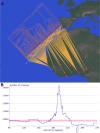A Mycobacterial Perspective on Tuberculosis in West Africa: Significant Geographical Variation of M. africanum and Other M. tuberculosis Complex Lineages
- PMID: 26964059
- PMCID: PMC4786107
- DOI: 10.1371/journal.pntd.0004408
A Mycobacterial Perspective on Tuberculosis in West Africa: Significant Geographical Variation of M. africanum and Other M. tuberculosis Complex Lineages
Abstract
Background: Phylogenetically distinct Mycobacterium tuberculosis lineages differ in their phenotypes and pathogenicity. Consequently, understanding mycobacterial population structures phylogeographically is essential for design, interpretation and generalizability of clinical trials. Comprehensive efforts are lacking to date to establish the West African mycobacterial population structure on a sub-continental scale, which has diagnostic implications and can inform the design of clinical TB trials.
Methodology/principal findings: We collated novel and published genotyping (spoligotyping) data and classified spoligotypes into mycobacterial lineages/families using TBLineage and Spotclust, followed by phylogeographic analyses using statistics (logistic regression) and lineage axis plot analysis in GenGIS, in which a phylogenetic tree constructed in MIRU-VNTRplus was analysed. Combining spoligotyping data from 16 previously published studies with novel data from The Gambia, we obtained a total of 3580 isolates from 12 countries and identified 6 lineages comprising 32 families. By using stringent analytical tools we demonstrate for the first time a significant phylogeographic separation between western and eastern West Africa not only of the two M. africanum (West Africa 1 and 2) but also of several major M. tuberculosis sensu stricto families, such as LAM10 and Haarlem 3. Moreover, in a longitudinal logistic regression analysis for grouped data we showed that M. africanum West Africa 2 remains a persistent health concern.
Conclusions/significance: Because of the geographical divide of the mycobacterial populations in West Africa, individual research findings from one country cannot be generalized across the whole region. The unequal geographical family distribution should be considered in placement and design of future clinical trials in West Africa.
Conflict of interest statement
The authors have declared that no competing interests exist.
Figures



References
-
- UNDP (2014) The 2014 Human Development Report—Sustaining Human Progress: Reducing Vulnerabilities and Building Resilience.
-
- Vitol I, Driscoll J, Kreiswirth B, Kurepina N, Bennett KP (2006) Identifying Mycobacterium tuberculosis complex strain families using spoligotypes. Infect Genet Evol 6: 491–504. - PubMed
Publication types
MeSH terms
Grants and funding
LinkOut - more resources
Full Text Sources
Other Literature Sources
Medical

